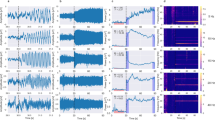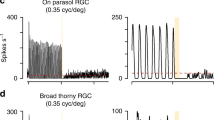Abstract
SINCE its discovery in 1964 by Brown and Murakami1, the early receptor potential (ERP) has been detected in retinas isolated from a variety of vertebrates. The ERP is evoked by an intense light flash of typical duration less than a few hundred microseconds. Its latency is shorter than 0.5 µs (ref. 2), and at physiological temperatures it decays in a few milliseconds. The ERP has two components in opposite polarity, R1 and R2; R2 (vitreous negative) is dominant at physiological temperatures, while R1 can be isolated by cooling to near 0° C (ref. 3). It is almost certainly generated in the outer segments of the photoreceptors4, most likely by charge displacements associated with conformational changes in photopigment or of neighbouring molecules2,5. In eyes fixed in formaldehyde the rise and decay times of the ERP are related in a simple manner to those of the stimulus flash6. In unfixed retinas, the ERP is more prolonged, and decays considerably later than the flash. It would be of considerable interest to know how the ERP behaves in unfixed retinas for really long flashes, particularly in view of recent results obtained from the lateral eye of Limulus by Smith and Brown7. They have described for the retina of this invertebrate a monophasic potential of rapid onset—the “photoelectric potential” (PEP)—with properties markedly similar to the vertebrate ERP. The stimulus was, however, a continuous arc xenon lamp focused to deliver several mwatts of radiant power to a single ommatidium, and the light pulses were essentially square waves of about 5 ms duration. The PEP recorded with a micropipette reversed in polarity as the membrane of a retinular cell was penetrated. The intracellular PEP attained a constant amplitude during the course of the light flash; it was not clear whether cooling produced a response of opposite polarity, as occurs for the vertebrate ERP.
This is a preview of subscription content, access via your institution
Access options
Subscribe to this journal
Receive 51 print issues and online access
$199.00 per year
only $3.90 per issue
Buy this article
- Purchase on Springer Link
- Instant access to full article PDF
Prices may be subject to local taxes which are calculated during checkout
Similar content being viewed by others
References
Brown, K. T., and Murakami, M., Nature, 201, 626 (1964).
Cone, R. A., Science, 155, 1128 (1967).
Pak, W. L., and Cone, R. A., Nature, 204, 836 (1964).
Arden, G. B., in IS CERG Symposium, 1966, Ghent, 51 (Karger, Basel/ New York, 1968).
Brindley, G. S., and Gardner-Medwin, A. R., J. Physiol., 182, 185 (1966).
Arden, G. B., Bridges, C. D. B., Ikeda, H., and Siegel, I. M., Vision Res., 8, 3 (1968).
Smith, T. G., and Brown, J. E., Nature, 212, 1217 (1966).
Hamasaki, D. I., J. Physiol., 167, 156 (1963).
Pak, W. L., in Cold Spring Harbor Symp. Quant. Biol., 30, 493 (1965).
Hagins, W. A., and McGaughy, R. E., Science, 157, 813 (1967).
Cone, R. A., in Cold Spring Harbor Symp. Quant. Biol., 30, 483 (1965).
Cone, R. A., Nature, 204, 736 (1964).
Brown, K. T., Nature, 207, 1249 (1965).
Goldstein, E. B., Vision Res., 7, 837 (1967).
Baumann, C., Vision Res., 6, 5 (1966).
Hagins, W. A., and McGaughy, R. E., Science, 159, 213 (1968).
Brown, J. E., Murray, J. R., and Smith, T. G., Science, 158, 665 (1967).
Katz, B., Nerve, Muscle and Synapse (McGraw-Hill, London, 1966).
Author information
Authors and Affiliations
Rights and permissions
About this article
Cite this article
FATECHAND, R. Generation of the Early Receptor Potential with Long Flashes. Nature 219, 390–392 (1968). https://doi.org/10.1038/219390a0
Received:
Revised:
Published:
Issue Date:
DOI: https://doi.org/10.1038/219390a0
Comments
By submitting a comment you agree to abide by our Terms and Community Guidelines. If you find something abusive or that does not comply with our terms or guidelines please flag it as inappropriate.



